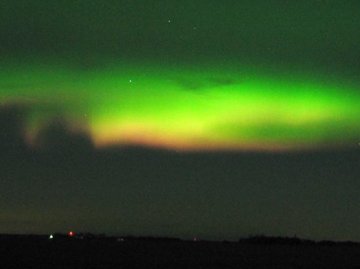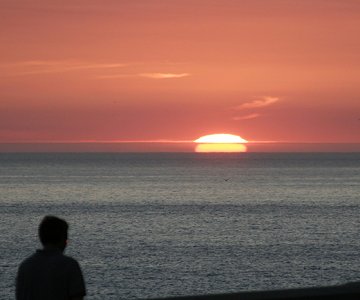 Planets. Comets. Auroras. Don't miss them! Sign up for Spaceweather PHONE.
Planets. Comets. Auroras. Don't miss them! Sign up for Spaceweather PHONE.
DAYLIGHT METEORS: There's a meteor shower in progress today--but don't expect to see any meteors. The display peaks in broad daylight. The annual Arietid meteor shower emerges from a point in the sky only 30 degrees from the sun. These meteors are thought to be debris from the sungrazing asteroid Icarus: full story.
SOLAR WIND: For the second day in a row, a solar wind stream is blowing against Earth. So far it has done little to spark a geomagnetic storm or auroras--except for one glorious minute last night:

"A vortex of auroras raced across the sky, tinged red at the bottom," says photographer Chris Douglas of Winnipeg, Canada. "The show lasted less than 60 seconds, but it was beautiful."
The solar wind is expected to continue blowing tonight. Be alert for your own glorious minute.
DOUBLE SUNSET: Photographer Oscar Blanco was watching the sun set from the Atlantic coast of Spain on June 5th when, suddenly, the sun split in two:

Photo credit: Oscar Blanco of La Coruna, Spain
Atmospheric optics expert Les Cowley explains what happened: "This remarkable sunset mirage was made by a temperature inversion, a cool air layer below a warmer one. The air layers bend the sun's rays to form the mirage. The lower sun is upside down! It rises as the upper sun sets."
"The mirage is so strong," he adds, "that the bent rays are 'ducted'. They are trapped between air layers and travel some distance around the curvature of the earth before they escape." More images: #1, #2

